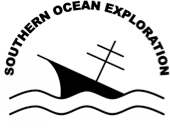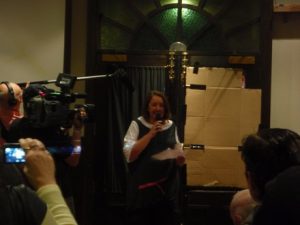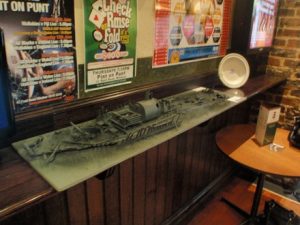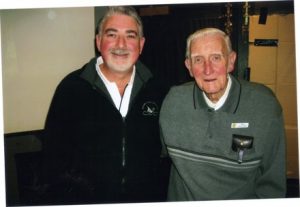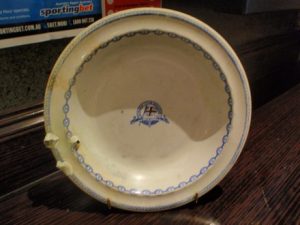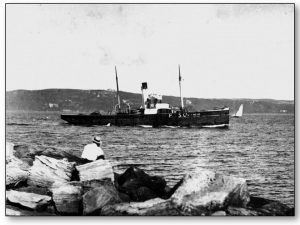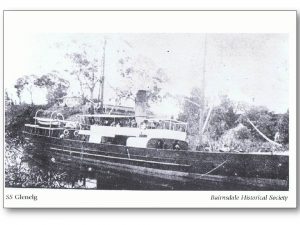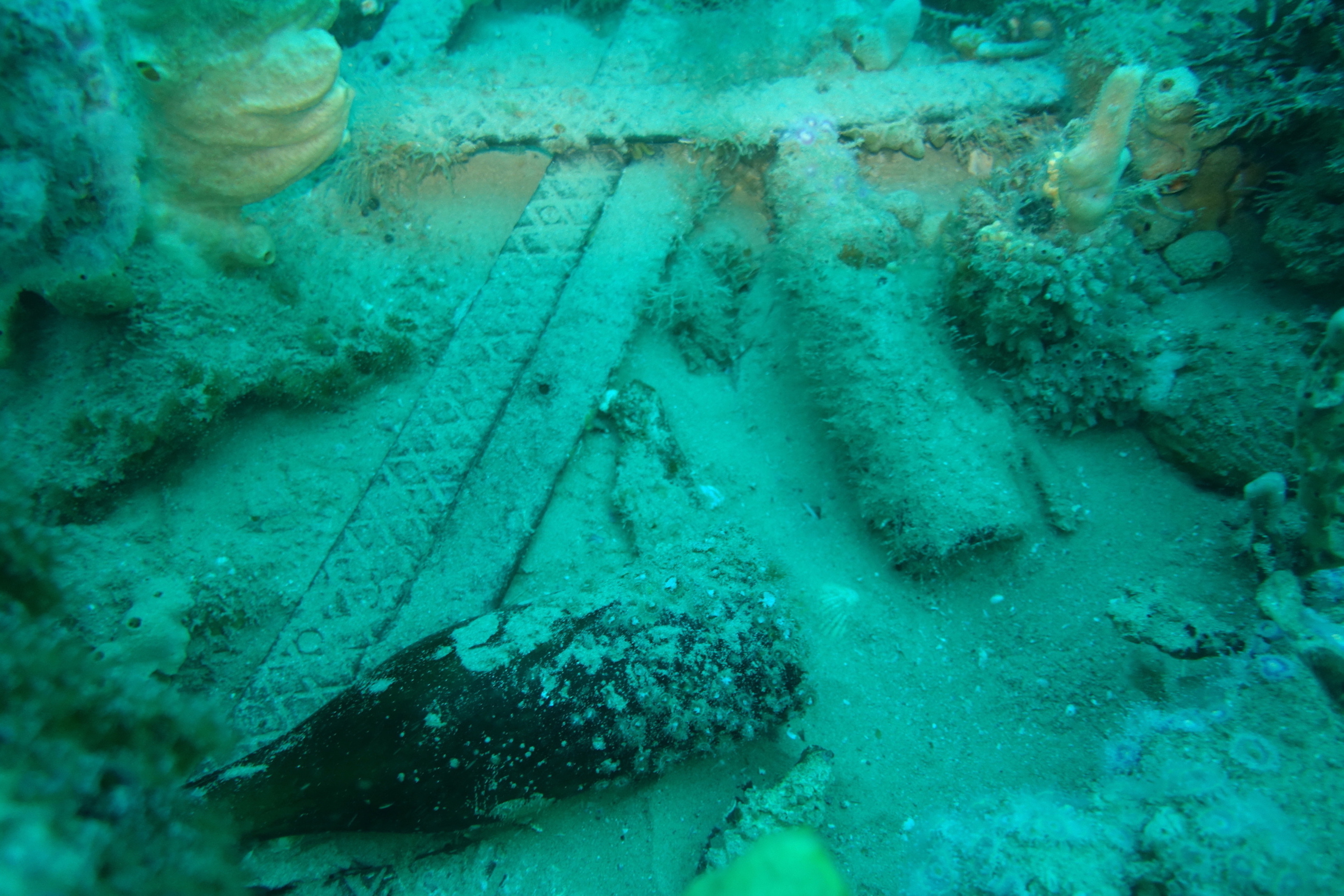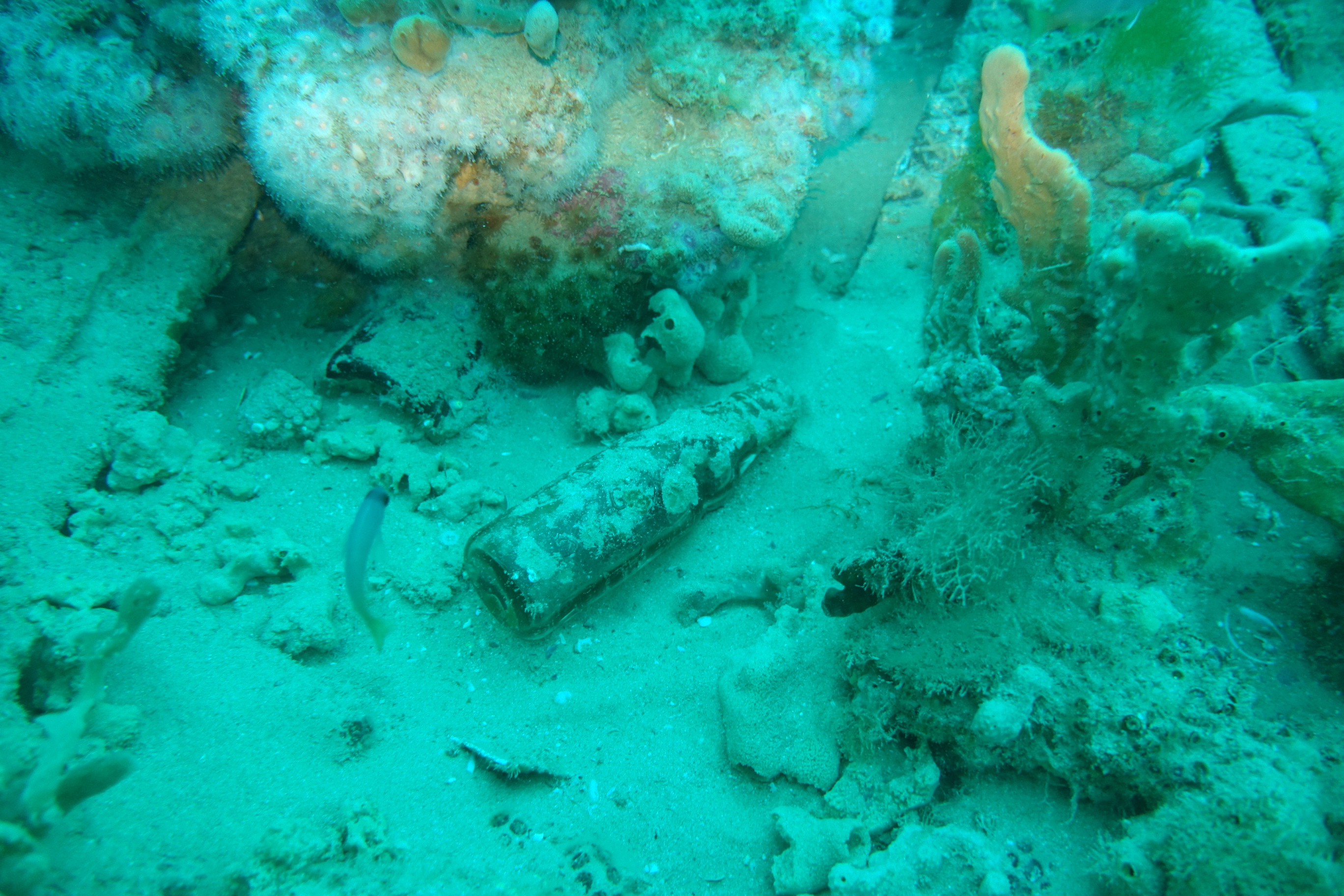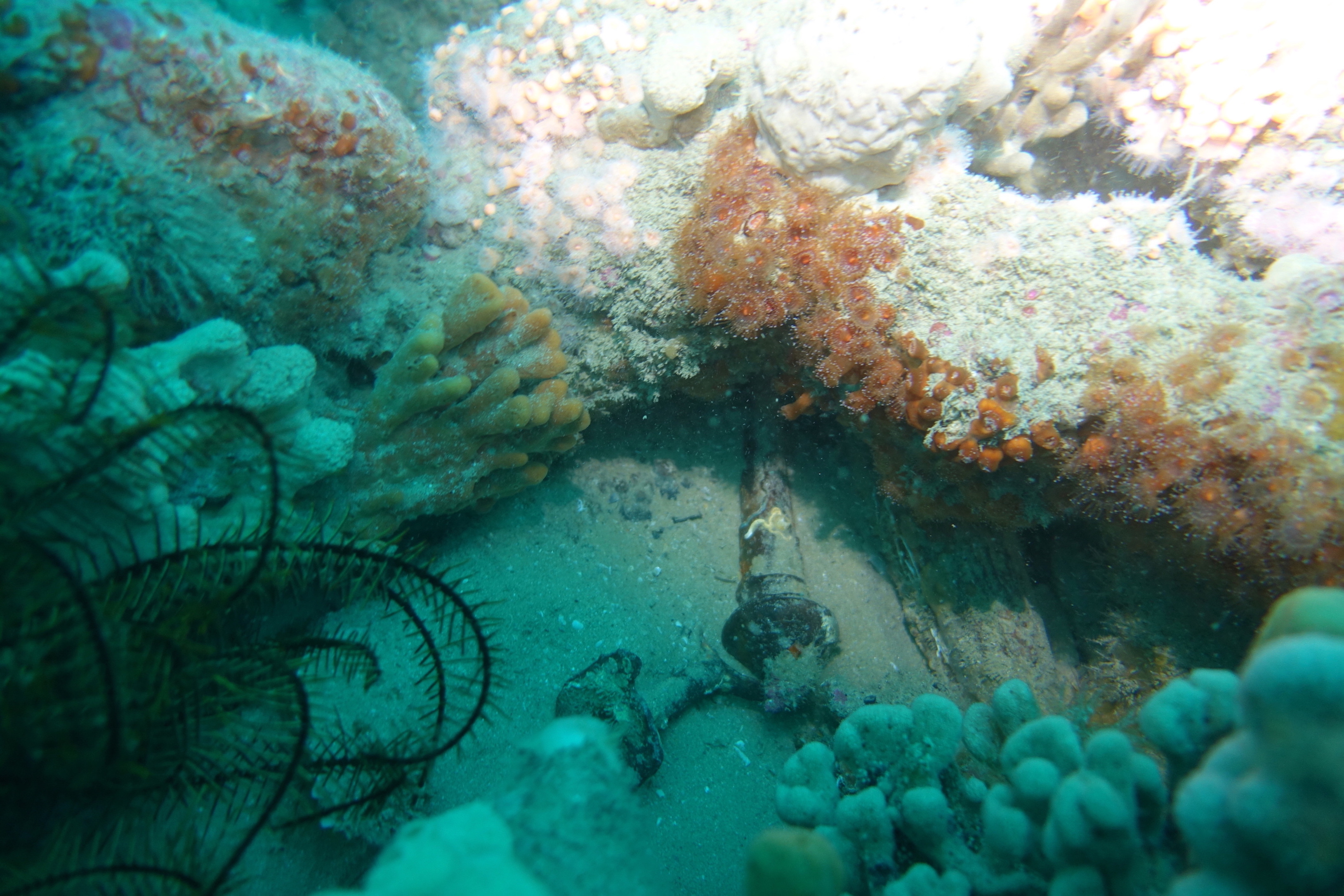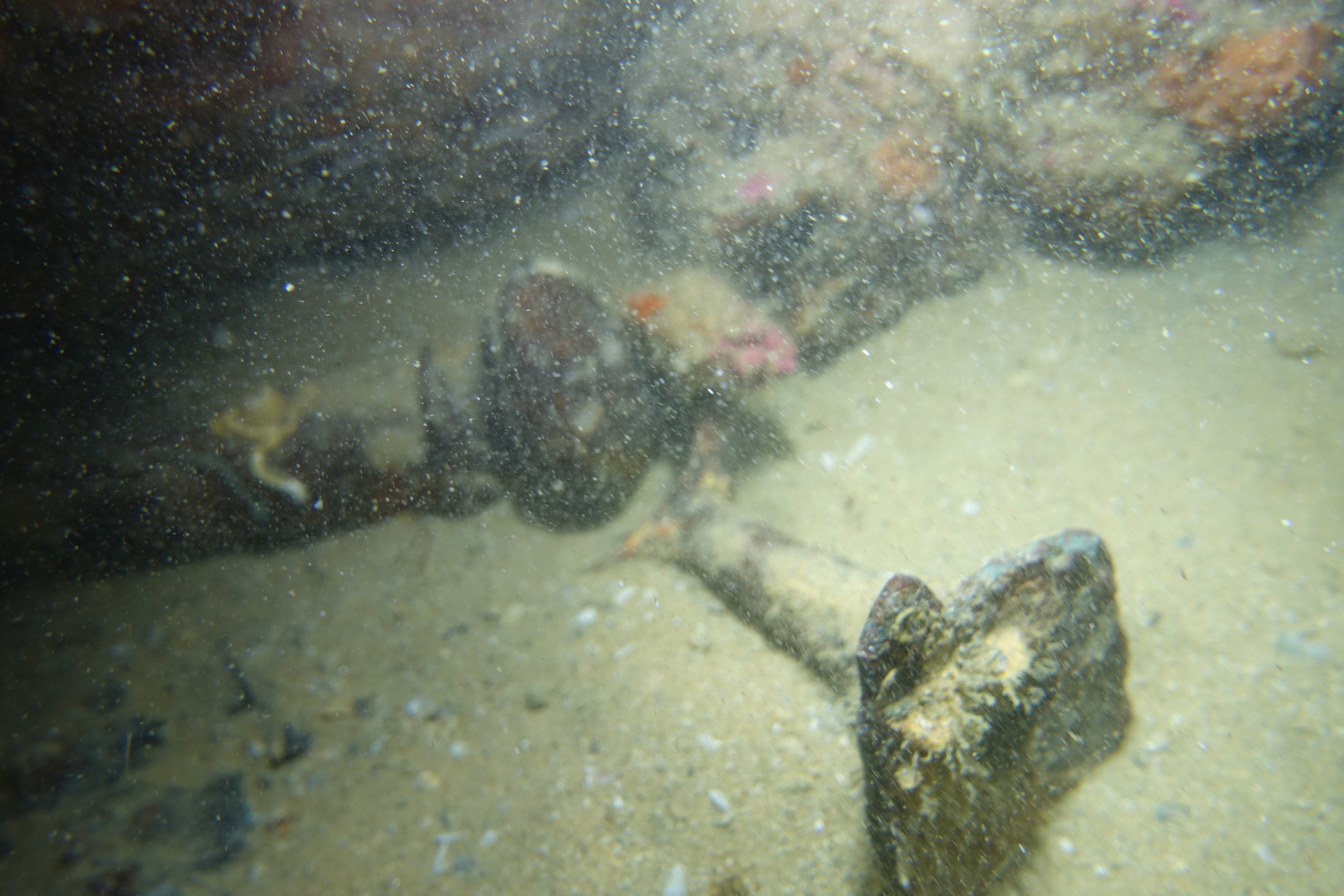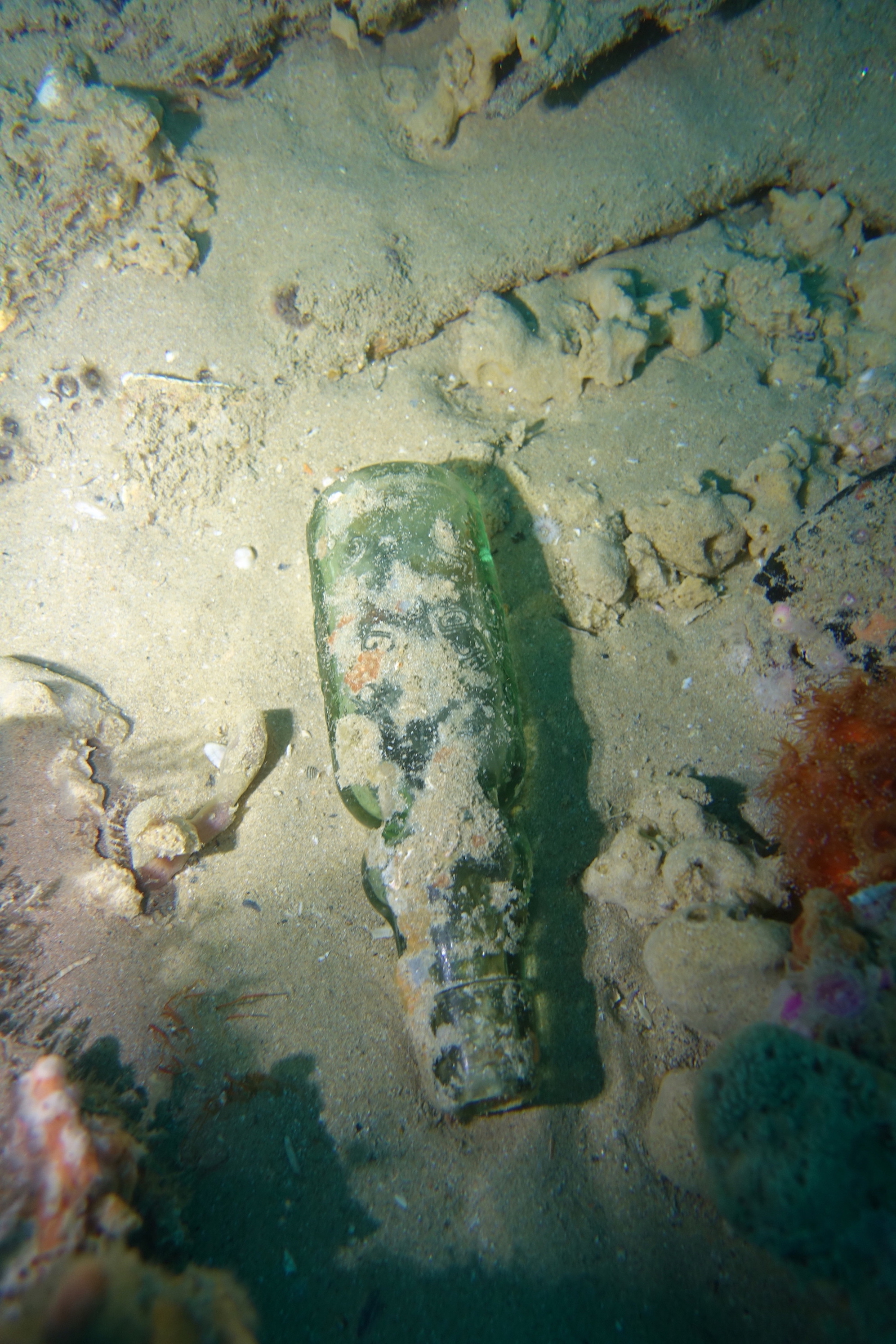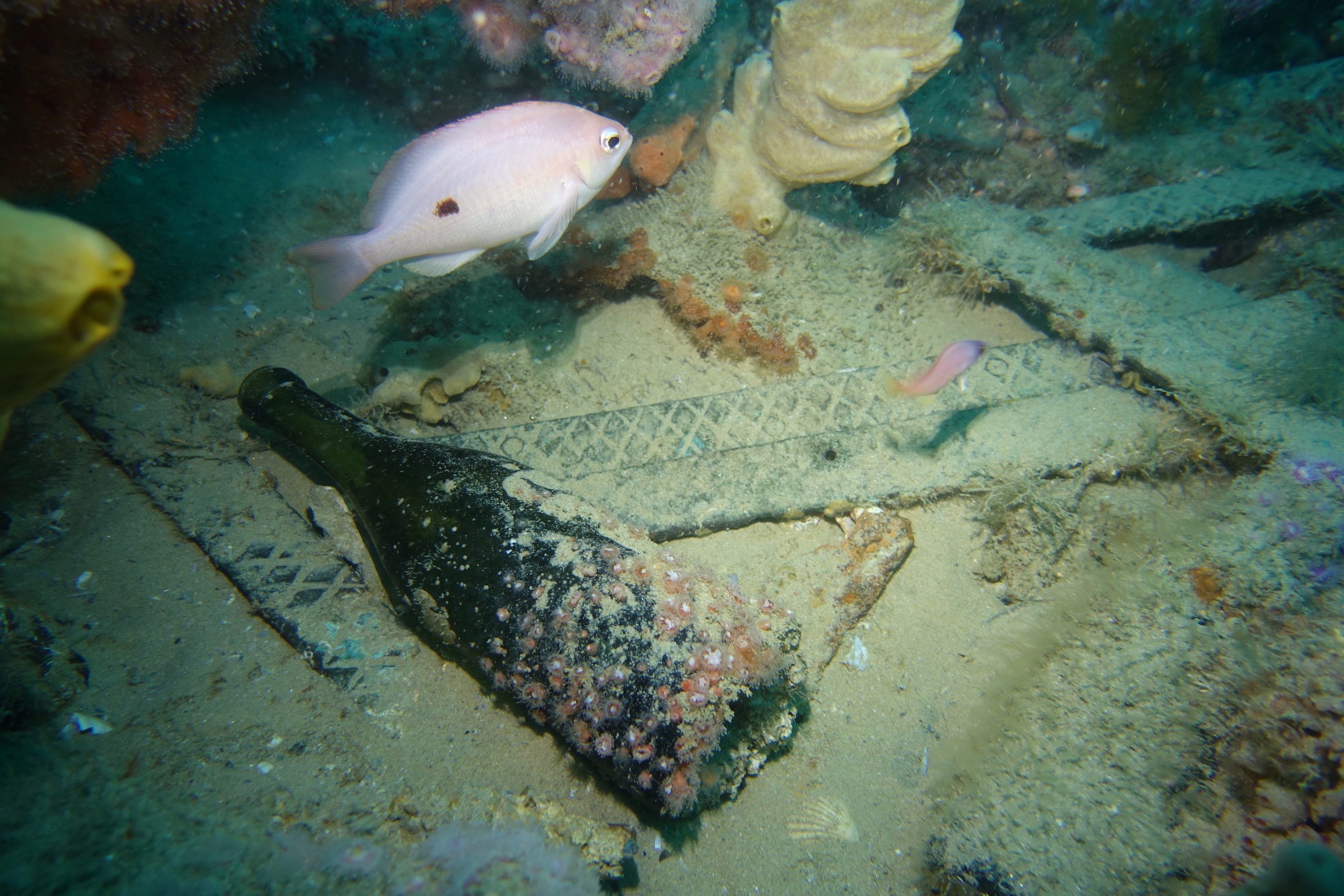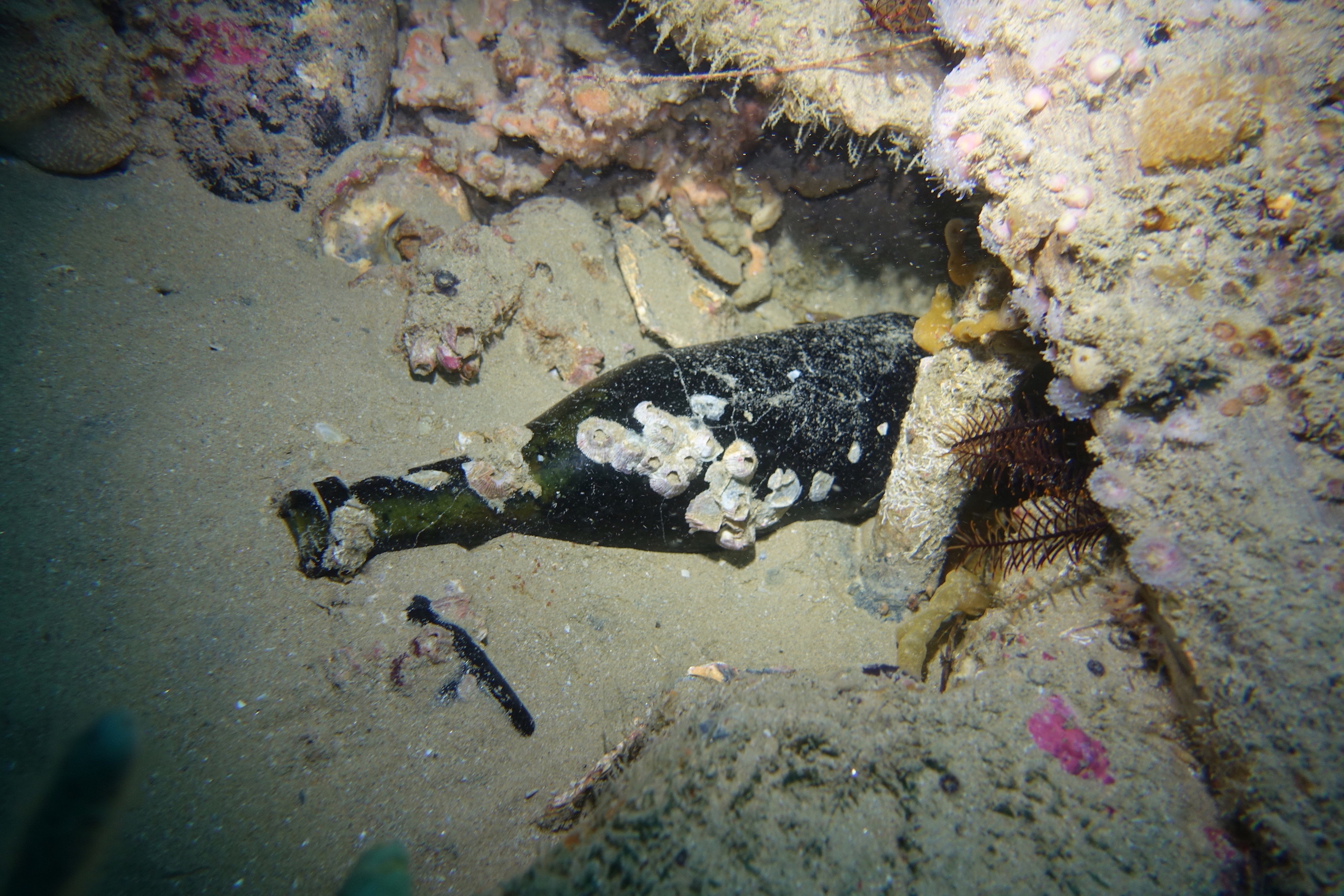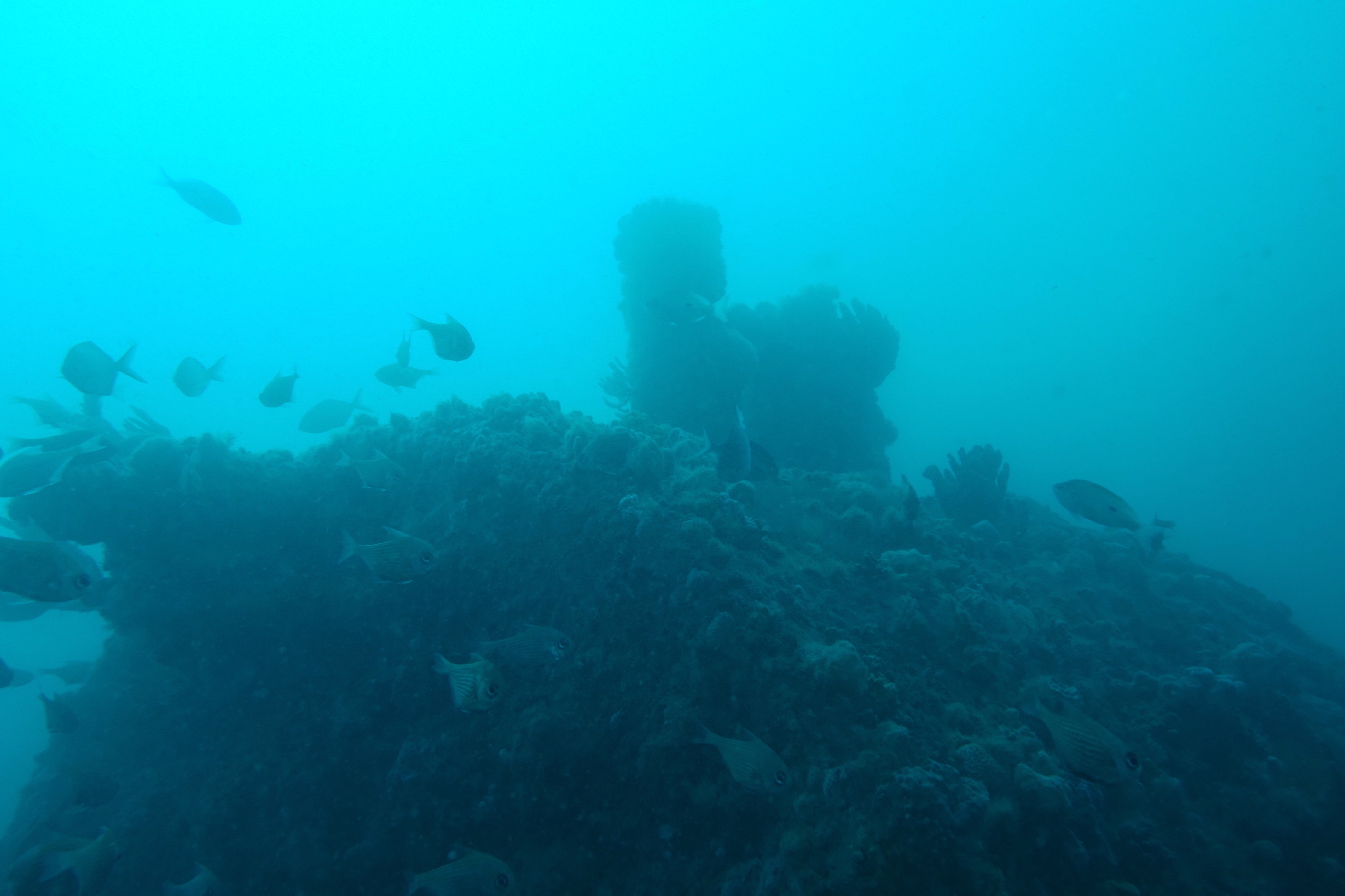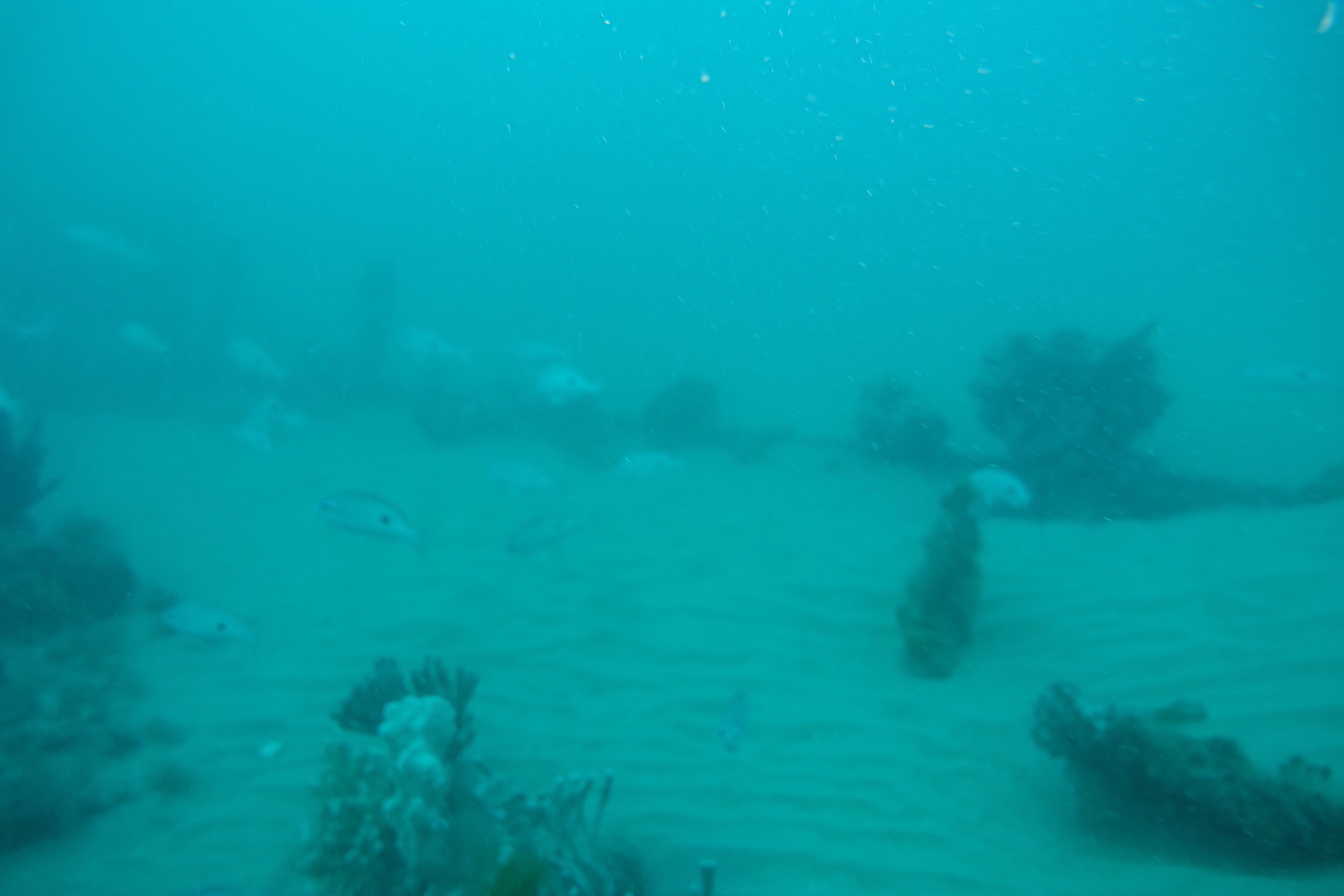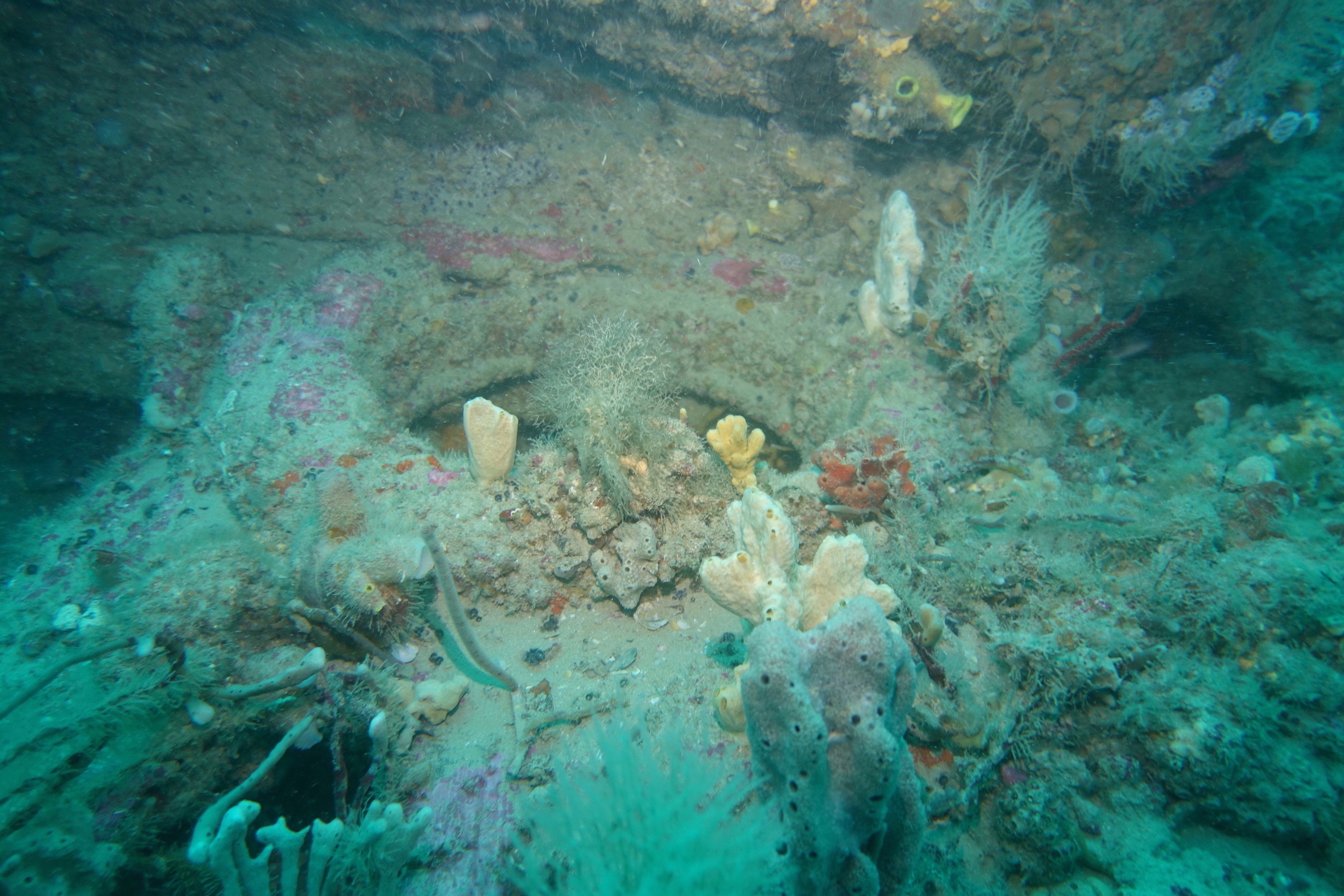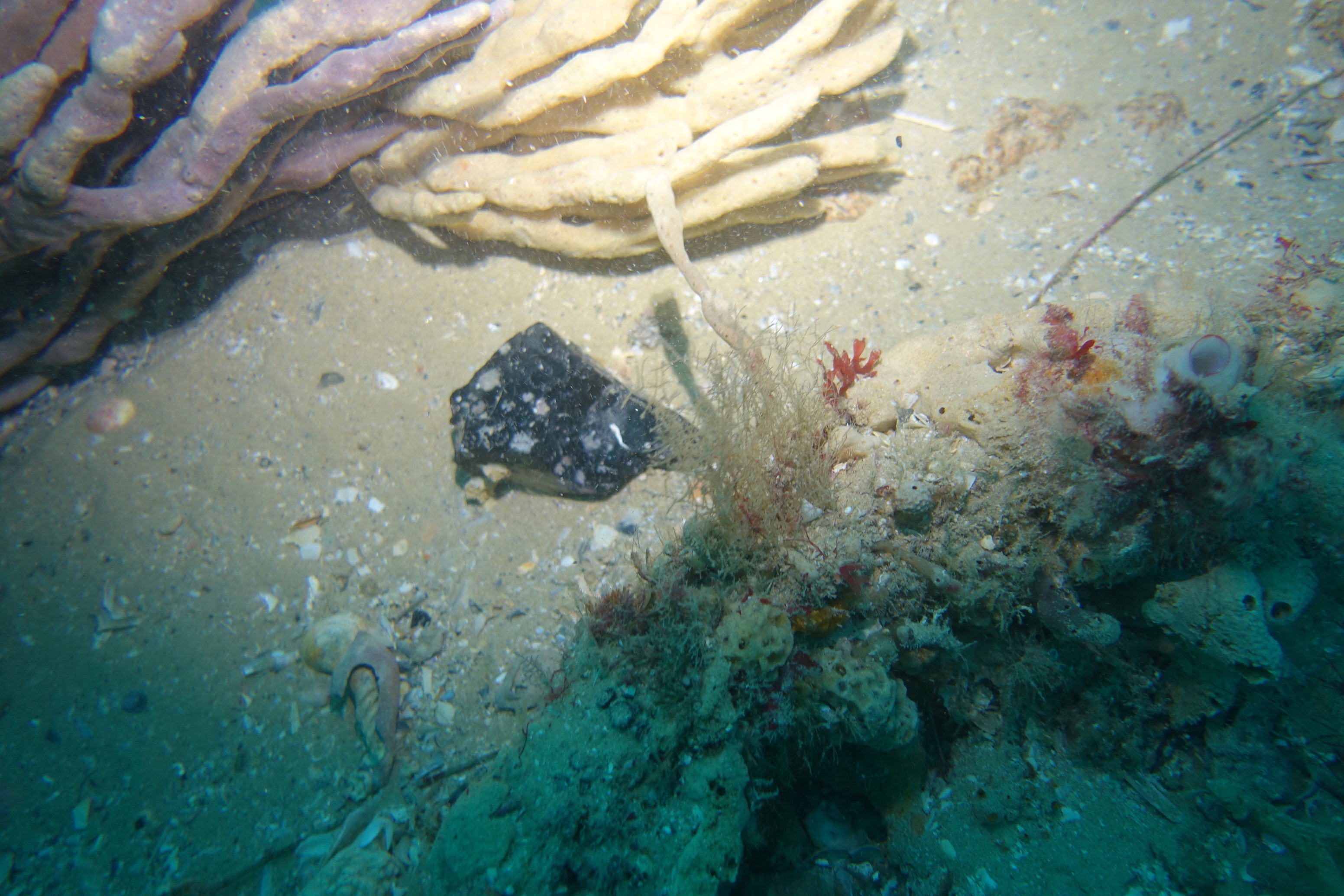Gordon Fyfe dives the Glenelg
The adventure all started when Terry Cantwell of White Water Documentaries arranged the ‘Pint On Punt’ evening, a get together for descends of the Glenelg tragedy. So impressed with the vision that he was seeing of the shipwreck Gordon started on a quest to visit the site in person. Gordon, along with his wife Elizabeth, first completed their Open Water Course, which gave them an 18 metre dive qualification. The pair were then to complete the IANTD Advanced Open Water Course which would give them the qualification required to dive the 30 metre site. Things did not always go to plan, however even though one full day of diving was lost, their level of training was well sufficient to allow them to both safely and confidently dive the site. When Justin McCarthy, principle of IANTD Australia, made himself available to personally escort Elizabeth, as her dive Instructor, to the wreck and I was to dive with Gordon all of a sudden things were back on track.
We had boats, boat drivers and divers all on standby as we watched the weather report each day. Bass Straight can be unforgiving at the best of times. We are fortunate to have the experience of long time sailors John Corby and Steve Cartlidge in the team. John with his uncanny ability ‘to see beyond the horizon’ when it comes to driving boats and his good friend Steve, just seems to know what the weather will do, even before the weather knows itself.
0700 hrs at the boat ramp, boats are launched and the dive briefing begins, we have a few first timers on the trip but most of the team have dived the site several times before. Liz and Gordon suit up, casual but methodical just as per their training, the boat drivers are prepping their boats, they know their role, they are prepared in advanced and all is well. This might be deep for Gordon and Liz but 30 metes is not generally considored a deep dive by experianced divers.[INSERT VIDEO]
 Master Instructor Peter Prentice & Dive Master Cal Mero work with Gordon and Liz to ensure their knowledge of dive theory is well understood.
|
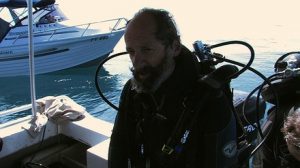 Gordon reflects on his visit to David Fyfe’s grave site.
|
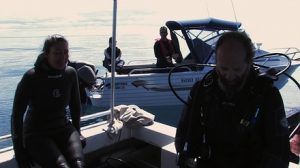 Gordon and Liz achieve a life time dream!!
|
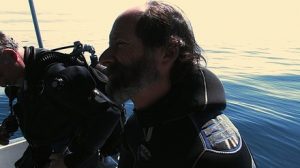 Special |
 Liz is escorted back to the boat.
|
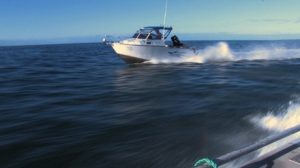 SOE make the most of the conditions.
|
 Liz enjoys the relaxation of some dive talk banter with the SOE boys. |
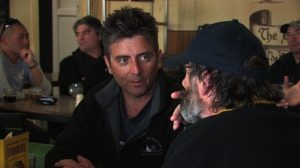 Martin and Gordon enjoy a meal and a chat after the dive. Martin is never one to miss the opportunity to gather information. |
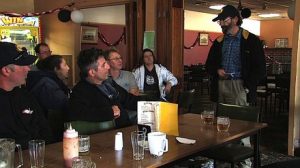 Gordon thanks the SOE team, but in particular the boat owners Mick Whitmore, Allan Easter, Joe Brothers, John Corby and Steve Cartlidge.
|
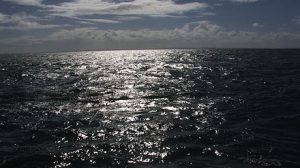 The sun sets on what is yet another brilliant day!!!!!!
|
Ships Construction
The SS Glenelg was completed in March 1875 by Aitken & Mansel of Glasgow
Scottland. She was an iron twin screw steamer of 210 gross tons (64 net tons)
and built on the dimensions of 135 ft in length, a breadth of 21 ft and a depth of
11.3ft. The Glenelg was driven by two compound steam engines totaling 85hp
from a single coal fired boiler; the engines were built in Glasgow by Rait &
Lindsay. She was clincher built with a round stern and she was rigged as a fore
aft schooner. The vessel carried two large lifeboats and had two holds with
steam winches.2
Name: SS Glenelg. Built: by Aitken & Mansel Whiteinch, Yard No 72
Engines: built by Rait & Lindsay, Glasgow
Propulsion: Steam compound, 2 x C2cy 8½kn 80nhp, 2scr
Built: 1875 Launched: Friday, 22/01/1875.
Ship Type: Iron passenger/ cargo steamship.
Tonnage: 210grt, 64nrt Length: 135.8 feet, Breadth: 21.1 feet, Depth: 11.3 feet
Ship Owners
1875 Elder, Smith & Co, Port Adelaide.
1881 William Wells, Port Adelaide.
1882 Thomas Hessleton, Sydney.
1882 Port Jackson Steamship Co Ltd, Sydney.
1891 E T Miles & Partners, Hobart.
1892 T A Reynolds & Co, Hobart.
1896 Union Steamship Co of New Zealand Ltd, Dunedin.
1898 J.B & A.J Ellerker, G. Carpenter & C. H. Jackson, Melbourne
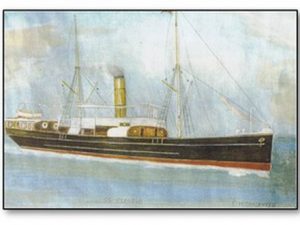
History
On May 24th 1875 the Glenelg held distinction of being the first southbound ship
to pass through the new Suez Canal. Designed to operate as a tug – passenger –
tender vessel, she also had the capacity to ship cargo. She worked out of Port
Adelaide and later worked in the St Vincent’s Gulf trade.3
In 1880, the SS Glenelg commenced service between Adelaide, Hobart and
Sydney. She made several voyages under the command of Captain S. Nicholson
until she was replaced by the SS Macedon. In 1880 the tonnage was adjusted to
read 210 gross and 76 net.
In July 1881 the Glenelg was sold to William Wells and in April 1882 sold to
Thomas Hesselton of Sydney, under whom she made a run to New Zealand for a
cargo of salvaged railway equipment. The Glenelg was sold again in July 1882 to
the Port Jackson Steamship Co Ltd of Sydney, and employed as a Manly ferry.
From January 1883 until end of March 1883 she was chartered to W Collins of
Brisbane and placed upon the Brisbane – Bundaberg run. In November 1891 she
was purchased by E T Miles & Partners of Hobart and placed upon the Hobart –
Strahan run, at times extending from Strahan to Melbourne.
In 1892 T.A. Reynolds & Company purchased the Glenelg and placed her on the
Hobart-Strahan-Melbourne run. In 1893 the ship was put on the Victorian coastal
run in opposition to Huddart Parkers SS Dispatch.
In 1896, the Glenelg had an anxious trip between Melbourne and Strahan, when
she encountered a heavy gale. Being a flush-decked ship, the big seas tumbled
over her low bow, rushing aft and eventually breaking over the engine room
grating and the water finding its way below and choking the pumps with coal. All
hands bailed with buckets, while her Master, Captain Lloyd headed for Circular
Head on Tasmania’s north west coast where he beached her. It was found that
packing had worked out of a tail-shaft gland. After repairs the ship was
refloated, and continued to Strahan. The ship was then sold to the Union
Steamship Company and continued to serve the west coast of Tasmania for a
further two years.
Due to the increasing trade of the Union Steamship Company, the capacity of the
Glenelg could not meet its needs and a larger vessel was sought out. In 1898 the
Glenelg was purchased from the Union Steamship Company by George Carpenter
of Lakes Entrance, C H Jackson of Bruthen and J B Ellerker of Melbourne. The
Glenelg then replaced the SS Argyle on the Melbourne to Gippsland Lakes run.SS Glenelg Sea Going Qualities.
The following text from Ian Boyd4 describes the Glenelg and her reputation as a
comfortable passenger ship.
The Glenelg first ran to Bairnsdale in June 1898. She had been expected to be a
most popular boat, contrasting as she did with other boats on the run, not only
as a good sea boat but for her superior speed and her first rate passenger
accommodation, whether forward in the steerage or aft in the saloon.
Passengers spoke highly of her comfort and sea going qualities. Being a twin
screw vessel was an enormous advantage when negotiating a difficult passage
like the Entrance to the lakes. Steering the vessel was greatly assisted by being
able to stop either the port or starboard screw as required. The ship’s boilers
and engines were powerful and perfect with the Captain’s cabin located
conveniently on the bridge, close to the wheel.
At the time the Glenelg was said to be altogether as smart and as well fitted and
up to date as a vessel in the trade could be expected to be.
Captain Lloyd, who was for many years in charge of Glenelg in the Melbourne to
Tasmania trade stated that “he had never travelled in a better boat, that she
made her time in all weathers, carrying the mails, and was a highly popular
passenger boat. He was confident that the vessel would do the trips, wharf to
wharf, in 26 hours and could be relied upon to keep her time, making her in
every sense, a popular vessel.”
Captain Leith who was in charge of the vessel on its first voyage to Bairnsdale
said that his experiences fully justified these encomiums. Captain Leith had been
in charge of the SS Maitland and the Argyle, the two predecessors of Glenelg.
“The Glenelg was 15 feet longer than Argyle and was probably the most
powerful boat on the Bairnsdale run at that time and carried two engineers and
three firemen. The vessel carried two large lifeboats and had two holds with
steam winches so that she could load and unload with unusual dispatch.”
The Final Voyage
On her final voyage the Glenelg was returning to Melbourne with 30 tons of
general cargo from Bairnsdale comprising hides, wattle bark, tallow, wool and
sundries; eight tons of general cargo from Metung and five tons of electric light
poles from Cunninghame (Lakes Entrance). In addition to this cargo, she had on
board approximately 25 passengers and a crew of 16 under the Command of
Captain English.
After taking on the last of its cargo at Lakes Entrance, the Glenelg left around
nightfall on the 24th March 1900. The sea grew rougher as the night progressed,
and eventually the Glenelg was battling a strong gale from the southwest. At
4:00am water was suddenly discovered pouring into the aft quarters of the
vessel. It had appeared that some hull plates had come loose during the storm
and the ship was sinking fast.
Efforts by the crew to bail out the inrushing water were unsuccessful and soon
after Captain English had no option but to order “abandon ship”. A lifeboat was
then launched with only 3 of the crew in it. This was due to it being on the
seaward side and being tossed about by the waves, passengers were reluctant to
get in. The second lifeboat was eventually launched with the majority of
passengers and remaining crew. The Captain, First Mate and possibly the Chief
Engineer stayed on the Glenelg and went down with the ship. The 3 crew
members in the first lifeboat attempted to get to the second boat to help with
the overcrowding. They were unsuccessful and eventually lost sight of the larger
boat, which was never seen again. The 3 crew members were at sea for a further
2 days before being coming ashore at Marlo.
Eventually the bodies of some of the victims were washed up along the 90- mile
beach and many others were never recovered. The loss of the Glenelg was one of
Victoria’s greatest maritime disasters and caused great distress and grief for the
small community of Lakes Entrance district and for many other families in across
Victoria. It is believed that up to 47 children lost their parents in the tragedy.
Ships Crews & Passengers
Full details of the number of passengers and crew was difficult to ascertain as
there are conflicting historical records.
Love states “it had on board 15 passengers and a crew of 16 under the Command
of Captain English.” A total of 31.6
The Argus Newspaper in its report on 29th March 1900 details 20 Passengers and 17
crew.
Ian Boyd, a local historian, provided names of all crew and passengers below
which equated to 16 crew and 25 passengers. This would put total souls on board
at 41, comprising 25 Passengers, 16 crew, of which 38 were deceased and 3
Survived.
Passengers
1. Mr. Hyatt, of Ballarat, accountant for Craig Williamson, Proprietary.
2. Mrs. Hyatt, whose eight year old, only child, remained at home in
Ballarat.
3. Mr. Barker.
4. Miss Baker.
5. Miss Bean.
6. Mr. Hand.
7. Mr. G. P. Scott, married, lived at Albert Park.
8. Mr. Henry Bertram Holland, aged 16. He was the son of Robert Henry &
Emily Holland.
9. Miss H. M. Anderson.
10. Mr. R. Weir.
11. Mrs. Emily L. Moran, sister of Charles Morris.
12. Mr. Cowell.
13. Mrs. Cowell.
14. Mr. John Holloway Griffiths. (Assistant printer at the Age).
15. Mrs. Martha Amy Griffiths, only daughter of Mr. William Burkby and
brother of Mr. Fred Burkby, both well known Daylesford business men.
16. Albert Griffiths, aged eight, son of the above.
17. Ethel Griffiths, aged twelve, daughter of the above.
18. Mr. R. Scott, farmer, St. Arnaud.
19. Mr. W. G. Scott who owned property at Coburg, but lived in Mowbray St,
Albert Park, married, a Board of Works collector, but was previously
employed at Pentridge.
20. Mr. R. Palmer, also a Board of Works collector. He had gone in company
with Mr. Scott.
21. Mrs Lynch and child of Epping.
22. Mr. J. Lillicrapp.
23. Mr. Stephens.
24. Miss Lily Stephens, who was his daughter, aged 11.
The last five passengers were in a party from Melbourne and were on a holiday
with Mr John Stephens, a well known Baker from Brunswick St Fitzroy.
Crew
1. The Captain. Tyrrell H. English, married, forty three, resident of
Hawthorn. (or Malvern). Captain English had for many years been purser on the
Julia Percy.
2. Chief Officer John Burke, married.
3. Chief Engineer D. Fyfe, about forty, married with family, (his wife was
formerly Alice Barrett.)
4. Second Engineer Arthur Mauldon, thirty five, of South Melbourne.
5. Fireman Tom Hatfield, married, of South Melbourne.
6. Fireman Con. Williams, married with three children.
7. Fireman M. Williams, single, of South Melbourne.
8. Steward W. Tomlinson, about thirty two, married with family.
9. Stewardess Mrs. Boyd, about fifty, a widow with family.
10. Boatswain H. Lapthorne of South Melbourne, husband of Florence,
married with two sons.
11. Able seaman. Peter Benson.
12. Able seaman. Charles Evans.
13. Seaman. George Wright, married.
Survivors:
1. Alexander Lamb, a single seaman, on his second trip on the Glenelg.
2. Ernest Thorne, the under-steward and a resident of Vermont, on his first trip as
a steward on the Glenelg.
3. Valentine Bundy, the ships cook, of South Melbourne.
Historical Photos
The Research
Overview
SOE had been researching the SS Glenelg for several years. In order to prepare for an on water search it was important to ascertain an approximate position for the wreck using on shore research based methods. Firstly, the survivors of the Glenelg gave an account of the time of sinking and the estimated speed of the ship. Knowing the time the ship left Lakes Entrance, it was possible to ascertain a dead reckoning of the approximate position of the wreck in relation to her departure point. The Glenelg left Lakes Entrance at 7pm and travelled for approximately 9.5 hours along the coast. It is stated by one of the survivors that the steamer was making at least 5 knots, possibly 6. Multiplying this out provides a distance of between 47 to 57 nautical miles westward of Lakes Entrance. Correlating this positioning with a CSIRO magnetic survey of Bass Strait there was an object of interest about 54 miles westward, about 7 miles offshore, in 17 fathoms. This position was the initial starting point for the development of search grids to commence on water search operations. Location of the SS Glenelg off the Ninety Mile beach Gippsland (Picture Googlemaps.)
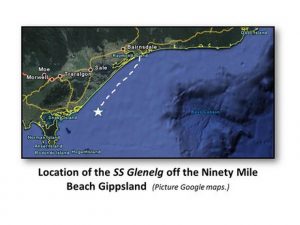 An initial search on the 5th of October 2008 failed to locate the wreck. A further search on the 28th June 2009 was successful and the wreck was located and dived.
An initial search on the 5th of October 2008 failed to locate the wreck. A further search on the 28th June 2009 was successful and the wreck was located and dived.
Positive Identification of the Wreck.
SOE believe they have positively identified this wreck as the SS Glenelg through
the following evidence.
1) Location of the wreck: The wreck is located very close to the estimated position from the survivors descriptions. There is no other known wreck in this vicinity.
2) Measured Dimensions: SOE has conducted initial measurement of the wreck and the dimensions correspond to that of the Glenelg.
3) Engine configuration: The engines and boiler of the wreck are of the same configuration as the SS Glenelg.
4) General configuration: The SS Glenelg had two steam powered winches for the forward and aft holds. Both winches have been identified on the wreck site.
5) Recovered artifact: With the permission of Heritage Victoria, a dinner plate was recovered from the wreck to assist with the identification. The plate contained the logo of the Tasmanian Steam Navigation Company. Although the Glenelg was never owned
the TSNC, she was owned by the Union Steam Ship Company prior to her sale to the final owners. The Union Steamship Company purchased the TSNC in 1891 and it is assumed that the crockery was distributed to other ships within this fleet. Therefore explaining its appearance on the SS Glenelg.
Site Plan

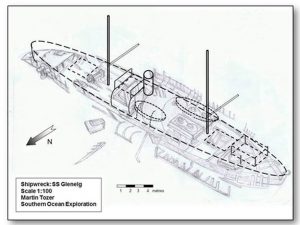
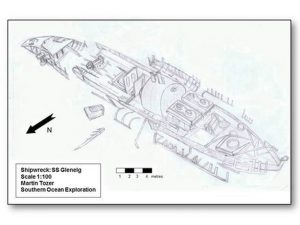
Additional SOE work
SOE are working closely with a film company to produce a video documentary
detailing the Glenelg’s history and is subsequent discovery.
Since the discovery of the SS Glenelg, Southern Ocean Exploration has been in
contact with many relatives of the victims of this shipwreck. Planning is under
way to conduct an on water memorial service and to lay a plaque on the wreck
site in memory of the victims.
SOE intend to do further archaeological site work and documentation of the
wreck. This will take place over the coming 12 months.
News and Events
Looting of the SS Glenelg – Channel Seven News report.
Photos
